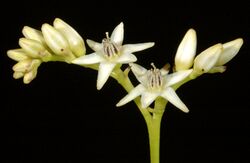Biology:Phlebocarya ciliata
| Phlebocarya ciliata | |
|---|---|

| |
| Scientific classification | |
| Kingdom: | Plantae |
| Clade: | Tracheophytes |
| Clade: | Angiosperms |
| Clade: | Monocots |
| Clade: | Commelinids |
| Order: | Commelinales |
| Family: | Haemodoraceae |
| Genus: | Phlebocarya |
| Species: | P. ciliata
|
| Binomial name | |
| Phlebocarya ciliata | |
| Synonyms[3] | |
|
Phlebocarya laevis Lindl. | |
Phlebocarya ciliata is a plant in the Haemodoraceae family,[1] native to Western Australia.[3]
It was first described by Robert Brown in 1810.[1][2]
Description
Phlebocarya ciliata has flat leaves with leaf blades that are 25-65 cm by 1.6-3.7 mm and have fringed margins (though sometimes only towards the apex or the base).[4] The flowerhead is about 1/3 to 2/3 as long as the leaves. The style is simple and there is one stigma.[4]
It flowers from September to November and grows in heath and woodland in swampy to well-drained sandy soils.[4]
Etymology
The species epithet, ciliata, is a Latin adjective, ciliatus (from cilium, "eyelash") and thus describes the plant as having fine hairs extending from an edge, like an eyelash.[5]
References
- ↑ 1.0 1.1 1.2 "Phlebocarya ciliata". Australian Plant Name Index (APNI), IBIS database. Centre for Plant Biodiversity Research, Australian Government. https://biodiversity.org.au/nsl/services/rest/name/apni/67916.
- ↑ 2.0 2.1 , pp. 301, https://www.biodiversitylibrary.org/page/36315578, Wikidata Q7247677
- ↑ 3.0 3.1 "Phlebocarya ciliata R.Br. | Plants of the World Online | Kew Science". http://powo.science.kew.org/taxon/urn:lsid:ipni.org:names:429821-1.
- ↑ 4.0 4.1 4.2 T.D.Macfarlane (2020). "Phlebocarya ciliata". Flora of Australia. Canberra: Australian Biological Resources Study, Department of Agriculture, Water and the Environment. https://profiles.ala.org.au/opus/foa/profile/Phlebocarya%20ciliata. Retrieved 2021-04-09.
- ↑ "ciliatus,-a,-um". http://www.plantillustrations.org/epithet.php?id_epithet=211598.
External links
Wikidata ☰ Q15316533 entry
 |

